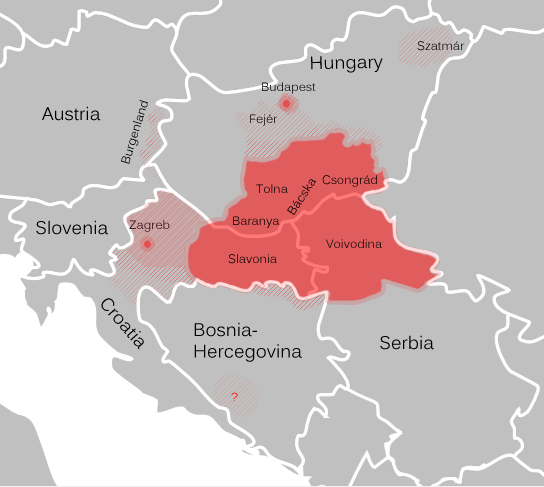|
Najbolji Hrvatski Tamburaši
Najbolji Hrvatski Tamburaši (in English Best Croatian Tambura Players) is a Croatian tambura group. The group was formed in 1983 as Zlatni Dukati. After a tour of America organized by the Croatian Fraternal Union, the band started to compose more music about Croatia. This came to coincide with the Croatian War of Independence which brought such traditional music back into the spotlight. In 1997 the group changed its name from Zlatni Dukati to Najbolji Hrvatski Tamburaši. The band was signed to Croatia Records. History Zlatni Dukati's first album was titled ''Ni sokaci nisu što su nekad bili''. The album was released by then Jugoton, now Croatia Records. The original band members were: * Zoran Bucković-prim * Stanko Šarić-basprim * Zdravko Šljivac-basprim * Zeljko Miloš (Yinks)-celo * Mario Pleše-kontra * Mato Lukačević-bas * Marijan Majdak-Vocals In the above-mentioned formation, Zlatni Dukati played only one season. Lukačević and Šarić continued to play under ... [...More Info...] [...Related Items...] OR: [Wikipedia] [Google] [Baidu] |
Croatia
, image_flag = Flag of Croatia.svg , image_coat = Coat of arms of Croatia.svg , anthem = "Lijepa naša domovino"("Our Beautiful Homeland") , image_map = , map_caption = , capital = Zagreb , coordinates = , largest_city = capital , official_languages = Croatian , languages_type = Writing system , languages = Latin , ethnic_groups = , ethnic_groups_year = 2021 , religion = , religion_year = 2021 , demonym = , government_type = Unitary parliamentary republic , leader_title1 = President , leader_name1 = Zoran Milanović , leader_title2 = Prime Minister , leader_name2 = Andrej Plenković , leader_title3 = Speaker of Parliament , leader_name3 = Gordan Jandroković , legislature = Sabor , sovereignty_type ... [...More Info...] [...Related Items...] OR: [Wikipedia] [Google] [Baidu] |
Tamburitza
Tamburica ( or ) or tamboura ( sh-Latn-Cyrl, separator=" / ", tamburica, тамбурица, little tamboura; hu, tambura; el, Ταμπουράς, Tampourás; sometimes written tamburrizza or tamburitza), refers to a family of long-necked lutes popular in Southern Europe and Central Europe, especially Serbia (in Vojvodina, Mačva and Posavo-Tamnava), Bosnia and Herzegovina, Croatia (of which it is the national string instrument), Slovenia, and Hungary ( predominantly amongst its ethnic South Slavic minority groups). It is also known in Burgenland, Austria. All took their name and some characteristics from the Persian tanbur but also resemble the mandolin and guitar in the sense that its strings are plucked and often paired. The frets may be moveable to allow the playing of various modes. The variety of tamburica shapes known today were developed in Serbia and Croatia by a number of indigenous contributors near the end of the 19th century. History There is little reliable data ... [...More Info...] [...Related Items...] OR: [Wikipedia] [Google] [Baidu] |
Croatian Fraternal Union
The Croatian Fraternal Union ( hr, Hrvatska bratska zajednica) (CFU), the oldest and largest Croatian organization in North America, is a fraternal benefit society of the Croatian diaspora based out of Pittsburgh, Pennsylvania, US. History and activities In the late fall of 1893 Croatian American journalist Zdravko V. Mužina issued a call for a convention to organize a fraternal benefit society for Americans of Croatian descent. Three hundred people met in response to the call on January 14, 1894 in Allegheny City, Pennsylvania. Only a handful of people signed up and paid dues to the new group. Mužina arranged for another meeting on September 2, 1894 which merged six Croatian societies into a new group, the Croatian Federation. This group changed its name to the National Croatian Society in 1897. In 1926 the National Croatian Society merged with the Croatian League of Illinois of Chicago, St. Joseph Society of Kansas City, Kansas and the New Croatian Society of Whiting, India ... [...More Info...] [...Related Items...] OR: [Wikipedia] [Google] [Baidu] |
Croatian War Of Independence
The Croatian War of Independence was fought from 1991 to 1995 between Croat forces loyal to the Government of Croatia—which had declared independence from the Socialist Federal Republic of Yugoslavia (SFRY)—and the Serb-controlled Yugoslav People's Army (JNA) and local Serb forces, with the JNA ending its combat operations in Croatia by 1992. In Croatia, the war is primarily referred to as the "Homeland War" ( hr, Domovinski rat) and also as the " Greater-Serbian Aggression" ( hr, Velikosrpska agresija). In Serbian sources, "War in Croatia" ( sr-cyr, Рат у Хрватској, Rat u Hrvatskoj) and (rarely) "War in Krajina" ( sr-cyr, Рат у Крајини, Rat u Krajini) are used. A majority of Croats wanted Croatia to leave Yugoslavia and become a sovereign country, while many ethnic Serbs living in Croatia, supported by Serbia, opposed the secession and wanted Serb-claimed lands to be in a common state with Serbia. Most Serbs sought a new Serb state within a Yu ... [...More Info...] [...Related Items...] OR: [Wikipedia] [Google] [Baidu] |
Croatia Records
Croatia Records is the largest major record label in Croatia, based in Zagreb ( Dubrava). Summary Croatia Records d.d. is a joint-stock company currently led by the chief executive officer Želimir Babogredac, a notable sound engineer. It releases mostly (but not necessarily) mainstream music, and it has signed many prominent Croatian musicians of various music genres such as Dražen Zečić, Arsen Dedić, Mišo Kovač, Josipa Lisac, Majke, Teška Industrija, Thompson, Maksim Mrvica, Crvena jabuka, Jelena Rozga, Novi fosili, Opća opasnost, Rade Šerbedžija, Jacques Houdek, Parni valjak, Leteći odred, Mladen Grdović, Dino Dvornik, Dino Merlin, Hari Rončević, Radojka Šverko, Giuliano, Mate Bulić, Disciplin A Kitschme, Srebrna krila, Divlje jagode, Indexi, Sinan Alimanović, Lu Jakelić, Mia Dimšić, Mia Negovetić, Nina Donelli and others. Today, Croatia Records claims to have 70% share of the Croatian music market and has 30 record shops. Being a contin ... [...More Info...] [...Related Items...] OR: [Wikipedia] [Google] [Baidu] |
Jugoton
Jugoton was the largest record label and chain record store in the former Yugoslavia based in Zagreb, SR Croatia. History Jugoton was formed in 1947. It is notable for releasing some of the most important former Yugoslav pop and rock records. In addition, the company owned a widespread network of record shops across SFR Yugoslavia. The company changed its name to Croatia Records in 1991, after Croatia seceded from Yugoslavia. Artists Jugoton notable for signing numerous eminent former Yugoslav pop and rock acts. Some of the artists that have been signed to Jugoton include: * Aerodrom * Ansambel bratov Avsenik *Silvana Armenulić *Atomi *Azra *Đorđe Balašević *Bele Vrane *Beograd *Halid Bešlić *Bezobrazno Zeleno *Bijele Strijele *Bijelo Dugme *Biseri *Borghesia * Bulevar *Cacadou Look *Crni Biseri *Crvena Jabuka * Crveni Koralji *Zdravko Čolić * Dah * Daltoni * Dʼ Boys *Delfini (Split band) * Delfini (Zagreb band) * Devil Doll * Divlje Jagode *Dorian Gray * Dubrova ... [...More Info...] [...Related Items...] OR: [Wikipedia] [Google] [Baidu] |
Štitar, Croatia
Štitar ( hu, Csitár) is a village and municipality in the Vukovar-Syrmia County in Croatia , image_flag = Flag of Croatia.svg , image_coat = Coat of arms of Croatia.svg , anthem = "Lijepa naša domovino"("Our Beautiful Homeland") , image_map = , map_caption = , capit .... According to the 2011 census it has 2,129 inhabitants. References Municipalities of Croatia Populated places in Vukovar-Syrmia County Populated places in Syrmia {{VukovarSyrmia-geo-stub ... [...More Info...] [...Related Items...] OR: [Wikipedia] [Google] [Baidu] |
Slavonia
Slavonia (; hr, Slavonija) is, with Dalmatia, Croatia proper, and Istria, one of the four historical regions of Croatia. Taking up the east of the country, it roughly corresponds with five Croatian counties: Brod-Posavina, Osijek-Baranja, Požega-Slavonia, Virovitica-Podravina, and Vukovar-Syrmia, although the territory of the counties includes Baranya, and the definition of the western extent of Slavonia as a region varies. The counties cover or 22.2% of Croatia, inhabited by 806,192—18.8% of Croatia's population. The largest city in the region is Osijek, followed by Slavonski Brod and Vinkovci. Slavonia is located in the Pannonian Basin, largely bordered by the Danube, Drava, and Sava rivers. In the west, the region consists of the Sava and Drava valleys and the mountains surrounding the Požega Valley, and plains in the east. Slavonia enjoys a moderate continental climate with relatively low precipitation. After the fall of the Western Roman Empire, whi ... [...More Info...] [...Related Items...] OR: [Wikipedia] [Google] [Baidu] |
Županja
Županja (, hu, Zsupanya, german: Schaupanie) is a town in eastern Slavonia, Croatia, located 254 km east of Zagreb. It is administratively part of the Vukovar-Syrmia County. It is inhabited by 12,090 people (2011). Županja lies on the Sava river opposite Bosnia and Herzegovina, and is the site of a border-crossing bridge with the town of Orašje in Bosnia and Herzegovina. The A3 highway Zagreb- Slavonski Brod-Belgrade passes north of it, and the city is also reachable by a local railroad from Vinkovci as well as the state road D55. The 2011 census recorded 96.72% Croats in the municipality. History Županja was ruled by Ottoman Empire between 1536 and 1687 as part of Sanjak of Syrmia. Since the Treaty of Karlowitz in 1699, until 1918, Županja (named ''ZUPANJE'' when a post-office was opened in 1861)Handbook of Austria and Lombardy-Venetia Cancellations on the Postage Stamp Issues 1850-1864, by Edwin MUELLER, 1961. remained in the Austrian monarchy (Kingdom of Croati ... [...More Info...] [...Related Items...] OR: [Wikipedia] [Google] [Baidu] |
Virovitica
Virovitica () is a Croatian city near the Hungarian border. It is situated near the Drava river and belongs to the historic region of Slavonia. Virovitica has a population of 14,688, with 21,291 people in the municipality (census 2011). It is also the capital of Virovitica-Podravina County. Name Virovitica has also historically been known by the names ''Wirowititz''/''Virovititz'' and ''Wirowitiza'' (German), ''Viroviticza'', ''Verewitiza'', ''Verowitiza'', ''Verowtiza'', ''Verőce'' ( Hungarian) and ''Varaviza'' (Italian), ''Viroviticza'' or ''Verucia'' (Latin). History The town is first mentioned in 1234. It was part of Ottoman Empire between 1552 and 1684 and was kaza centre initially in Sanjak of Pojega (1552–1601), later in Sanjak of Rahoviçe in Kanije Eyalet (1601–1684) until the Habsburg conquest in 1684. In the late 19th century and early 20th century, Virovitica was a district capital in the Virovitica County of the Kingdom of Croatia-Slavonia. Demographics The ... [...More Info...] [...Related Items...] OR: [Wikipedia] [Google] [Baidu] |
Croatian Musical Groups
* Hrvatski (other)
* Hrvatsko (other)
* Serbo-Croatian (other)
{{disambiguation
Language and nationality disambiguation pages ...
Croatian may refer to: *Croatia *Croatian language *Croatian people *Croatians (demonym) See also * * * Croatan (other) * Croatia (other) * Croatoan (other) Croatoan may refer to: * Croatoan Island (now ''Hatteras Island'') on the Outer Banks of North Carolina * Croatan tribe, alternately spelled "Croatoan" *The word "Croatoan", found carved into a tree on Roanoke Island at the site of the Lost Colon ... [...More Info...] [...Related Items...] OR: [Wikipedia] [Google] [Baidu] |



